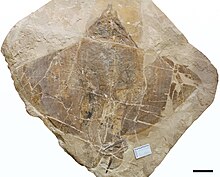

| Dasyomyliobatis
| |
|---|---|

| |
| Holotype specimen | |
| Scientific classification | |
| Domain: | Eukaryota |
| Kingdom: | Animalia |
| Phylum: | Chordata |
| Class: | Chondrichthyes |
| Subclass: | Elasmobranchii |
| Superorder: | Batoidea |
| Order: | Myliobatiformes |
| Family: | †Dasyomyliobatidae Marramà et al, 2023 |
| Genus: | †Dasyomyliobatis Marramà et al, 2023 |
| Species: |
†D. thomyorkei
|
| Binomial name | |
| †Dasyomyliobatis thomyorkei Marramà, Villalobos-Segura, Zorzin, Kriwet & Carnevale, 2023 | |
Dasyomyliobatis is an extinct stingray genus in the monotypic family Dasyomyliobatidae, of the order Myliobatiformes.[1] It contains a single species, D. thomyorkei, known from the Eocene Monte Bolca Lagerstätte of Italy. The specific epithet references the English musician and Radiohead vocalist Thom Yorke.[2]
The genus is characterized by a unique hybrid dentition and pectoral fin morphology that allowed the shift from undulatory to oscillatory swimming (and a resulting shift from a benthic to pelagic lifestyle), and to exploit a variety of prey from soft-bodied to hard-shelled organisms.[3] As suggested by the genus name, it displays intermediate traits between the whiptail stingrays (Dasyatidae) and the eagle rays (Myliobatidae), and can thus be considered a transitional form in the origin of pelagic rays. Dasyomyliobatidae is thought to represent a sister group to the Myliobatidae, and the two groups likely diverged during the Late Cretaceous.[2]

The Monte Bolca formation is thought to represent a shallow sea of the Tethys Ocean with scattered coral reefs and seagrass beds. With its combination of traits, Dasyomyliobatis may have been able to forage in both these shallow-water ecosystems as well as the open ocean.[2]
| Dasyomyliobatidae |
|
|---|---|
This article about prehistoric Batoidea is a stub. You can help Wikipedia by expanding it. |